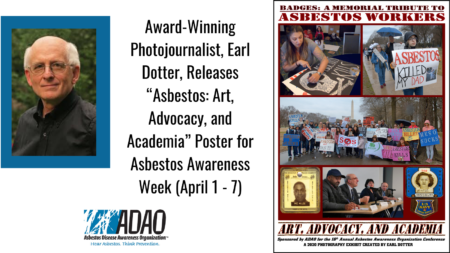Posted on March 29, 2021
 Since our founding in 2004, the Asbestos Disease Awareness Organization (ADAO) has been using art to drive our advocacy. Storytelling is at the heart of ADAO’s work, helping us to translate the experiences of victims and expertise of scholars alike into more accessible forms that help all parties be seen, felt, heard, and remembered. We’ve experimented with a myriad art forms to deliver our message––from film to music and everything in between. In the digital era, graphic design has become invaluable to our messaging efforts.
Since our founding in 2004, the Asbestos Disease Awareness Organization (ADAO) has been using art to drive our advocacy. Storytelling is at the heart of ADAO’s work, helping us to translate the experiences of victims and expertise of scholars alike into more accessible forms that help all parties be seen, felt, heard, and remembered. We’ve experimented with a myriad art forms to deliver our message––from film to music and everything in between. In the digital era, graphic design has become invaluable to our messaging efforts.
It is an honor and privilege to work with award-winning photojournalist Earl Dotter. Since 2015, Earl has dedicated his time to creating the exhibit, “BADGES: A Memorial Tribute to Asbestos Workers”, which masterfully captures the health impact and injustice of asbestos exposure and each year features different posters honoring those who have suffered from and fought asbestos.
For decades, Earl has used his art to advocate for occupational safety, be a voice for those who work in hazardous jobs, and provide an invaluable partnership to ADAO. This year’s poster features Julie Gundlach, a nearly 13-year mesothelioma survivor, preparing for the first-ever March for Justice and Remembrance, held March 5, 2019 in Washington, D.C. The march was organized in conjunction with ADAO’s 15th Annual International Asbestos Awareness and Prevention Conference and Day Five of 2019 Global Asbestos Awareness Week. Earl’s work shows other participants from the march, standing strong in the nation’s capital, sternly telling Congress that it’s time to ban the carcinogen once and for all.
Each poster within the BADGES exhibit features ID badges worn by asbestos workers alongside historic photographs of work sites, product advertisements, vintage photos, and product catalogs from industrial companies, connecting the human faces to the industry. From the frontlines of 9/11 to the Mount Sinai Medical Center operating room, ‘asbestos fighters’ work diligently to prevent and cure deadly asbestos-caused diseases. Earl’s work has showcased the human toll this carcinogen takes on not only those who get sick, but everyone around them.
BADGES also features real-life workers who spent their lives unknowingly mining and manufacturing products containing a lethal amount of asbestos, even though their employers knew the danger of the carcinogen. The badges capture the profit-over-people culture that threatened and eventually killed many of the faces you see. It is hard to emphasize how stunning, moving, and educational the work is, and we are incredibly grateful to Earl for continuing this project.
Linda Reinstein
Social Networks
————————————————————————————————————-
2015: Horing Dr. Irving Selikoff
2016: Commemorating the death of Alan Reinstein, Veteran and shipyard worker, and the late husband of Linda Reinstein, co-founder of ADAO
2017: Honoring Barbara Boxer for championing the Toxic Substances Control Act
2018: Honoring Emergency Responders and Caregivers
2019: Progress and Challenges from the Frontlines 2020/2021: BADGES poster “Art, Advocacy, and Academia” presented visual examples of how ADAO members are graphically conveying the harm caused by Asbestos to the Public and Congress
2020/2021: The theme is, “Art, Advocacy and Academia” which shows Julie Gundlach, a Mesothelioma patient, creating a poster for the 2019 March for Justice to advocate for an asbestos ban through art and advocacy.
Learn more about Earl and his 50 years photographing some of the most hazardous and dangerous occupations in America, beginning with coal miners in the 1970s. His work was published in the 1998 exhibit and book, “THE QUIET SICKNESS: A Photographic Chronicle of Hazardous Work in America.” Since then, he has continued to document workers who put their lives at risk for their jobs. In 2000, Earl received an Alicia Patterson Foundation Fellowship to document commercial fishing, one of the nation’s most dangerous trades. After 9/11, he photographed the rescue recovery effort at Ground Zero, work that ultimately won him APHA’s Alice Hamilton Award. Before COVID-19, Dotter was touring his retrospective exhibit, LIFE’S WORK, A Fifty Year Photographic Chronicle of Working in the U.S.A. His recently published book of the same name is a companion to the touring exhibit. Earl has also been a Visiting Scholar at the Harvard School of Public Health since his appointment in 1999. During COVID, Earl has created a Zoom presentation: ESSENTIAL WORKERS in the Time of COVID-19.
